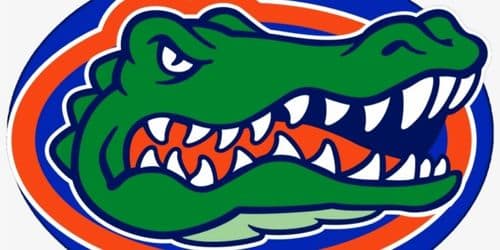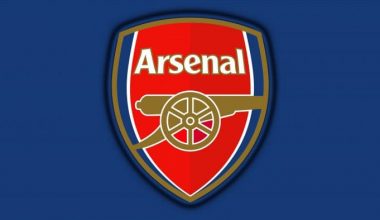The Florida Gators are the intercollegiate sports teams that represent the University of Florida and are based in Gainesville. The National Collegiate Athletic Association (NCAA) and the Southeastern Conference (SEC) are two of the most important college sports organizations in the United States. “Gator Nation” is the name for the University of Florida’s sports teams, alumni, and sports fans as a whole. Currently, the University of Florida fields teams in twelve women’s sports and nine men’s sports. In the early 1900s, the University of Florida Gators’ main logo was a picture of an alligator. However, in the new version of the Florida Gators logo, only the alligator’s head appears, which was first used in 1995. One more thing: the alligator is perceived as attacking because its mouth is open and showing teeth.
Come along if you want to learn more about the University of Florida Gators and the history behind its logo.
Overview
East Florida Seminary, which later became the University of Florida, was founded in Ocala. Along with Florida Agricultural College, Normal and Industrial School St. Petersburg, and South Florida Military College. It was one of four early predecessors to the contemporary university. The administrative hub is located in the former seminary, which served as the organization’s home base. It also holds the distinction of being Florida’s first publicly funded university.
Gainesville residents successfully fought for their city’s right to build a central campus. And a commission gave its stamp of approval to the project in 1905. William A. Edwards was the primary designer of the earliest government structures. He gave them a gothic cathedral look. In 1906, classes moved to the brand-new campus. There were 105 freshmen that year at the university. Its previous name, the University of the State of Florida, was abbreviated to its current form in 1909.
The alligator was officially adopted as the school mascot in 1911 after being recommended by students. At first, it was only on officially licensed pennants that it became well-recognized as a symbol of the institution. The rationale for such a bizarre choice was easy this species is numerous in the city’s outskirts, in the freshwater lakes of Florida. The mascot’s popularity skyrocketed, and the name was soon adopted by the athletics department. Concurrently, the school’s official colors blue and orange were chosen. They basically serve as a link between the university and its past. The East Florida Seminary opted for an orange and black color scheme. Meanwhile, the school colors at Florida Agricultural University were blue and white.
The college logo contains the text. It features the institution’s name. The abbreviation “UF” is on the left while.” The University of Florida” is written to its right, across a bright orange stripe.
History and Evolution of Florida Gators Logo
To this day, the University of Florida is the crown jewel of the State University System of Florida. It is also one of the finest academic institutions in the entire country. Academically, it’s at the very highest R1 level of distinction. Its organizational makeup consists of 16 colleges and universities and around 150 research centers and institutes.
Over a hundred and twenty students get master’s degrees while seventy-two earn doctorates across the fields of business, law, engineering, medicine, pharmacy, veterinary science, and dentistry. In addition, the university’s athletic program is among the best in the Southeastern Conference and in Division I of the NCAA. While the university is situated in Gainesville, Florida, the year 1835 marks its beginning as an institution.
There are generally three different logos associated with the University of Florida’s sports teams (known as the Gators). The primary insignia features a crocodile’s head, and secondary emblems include a block “F” and a wordmark.
In the early 1900s, the alligator was selected as the logo for the University of Florida Gators football team. While attending UVA in Charlottesville in 1908, Austin Miller and his father Phillip Miller placed an order for alligator pennants. Austin Miller later explained that he decided on this vicious animal since it is indigenous to Florida and he was unaware of any other school that has chosen it as its mascot. In addition, there have been other iterations of the alligator logo since then.
Florida Gators Logo- 1966
The original logo consisted of just the letter “F,” therefore it was quite simple. Nonetheless, there was something off about its appearance due to the asymmetry.
Florida GatorsLogo – 1979
On the other hand, this one was somewhat chaotic. A boot with elaborate decorations and a map of Florida were included. Behind them, a circle was formed by two abstract shapes.
Florida Gators Logo- 1995
The Florida Gators’ emblem now features the recognizable alligator. A good sports logo, thanks to the sharp teeth and the fierce look in the eyes.
Florida Gators Logo- 2013 to Today
The danger posed by the Florida Gators sports teams inspired the designers to switch from orange to red. That’s all that happens to the logo which is still in use. Aside from that, nothing else was altered.
Even though the Florida Gators basketball team has been around since 1915, she has had mixed results up until the mid-1980s. However, the long time since the stadium and coach have been present may be to blame. Their home arena, Exactech Arena at the Stephen C. O’Connell Center, didn’t even open until 1980, and Norm Sloan didn’t become president until 1960.
Since Billy Donovan took over as head coach of the men’s team in 1996, the team has only become better. However, Mike White took over from him in 2015. The basketball team he coached in his first year made it to the NIT tournament. The Lady Gators women’s basketball team on the other hand first started representing the university in 1975. They then went on to win the state championship the following year.
In 1906, the University of Florida began officially supporting the football team. Since the sports teams have taken home a total of eight SEC titles and three NCAA titles. They also competed in almost 40 state tournaments.
The baseball team has done great things for the university it was founded in 1907. Andy Lopez’s tenure as a trainer (1995-2000) is widely regarded as one of the most fruitful. This is a result of his amassing 50 victories before the end of his second season in charge. In contrast to its forerunners, the current Florida Gators emblem, which was approved in 1995, solely shows the alligator’s head. The creature’s gaping jaw and exposed teeth give off an angry appearance.
Florida Gators Symbol
Formally, the alligator pattern has changed very little, but the palette has shifted slightly. The current Florida Gators logo, which was approved in 1995, portrays simply the alligator’s head rather than the entire animal, as was the case with earlier versions of the emblem. Its wide mouth displays sharp fangs, giving the creature a hostile appearance.
Block “F” Logo
Signifying the University of Florida’s Gators, the logo is a capital “F” in italicized sans serif font. The inside of the letter is blue, while the border is orange.
Seal
The university seal is based on the flag of the state of Florida. However, instead of using the entire spectrum of color, it was created in black and white. A female Native American is depicted in the central circle. She’s scattering hibiscus blossoms all over the place. In the background, a tree stands tall. This is not a true palm tree but rather a palm-shaped sabal, which is a subspecies of the true palm tree. It’s naturalized and now dominates the landscape.
Tobacco smoke billows from the stacks of a steamship as the sunrise in the backdrop (the print depicts broad white rays against a blue sky). On the top of the ribbon is the Latin phrase “Civium in moribus rei publicae salus.” While at the bottom is the English phrase “In God We Trust.” A wide ring bearing the institution’s name and the year it was established also surrounds the core section. There are six stars, three on each side, separating these inscriptions written in Old English writing. While a twisty rope forms the framework for this A-frame enclosure.
Florida Gators Logo Font
The logotype uses a custom-made font that was made to look like handwriting. The white and blue outlines really bring out the roundness of the letters, making them look somewhat chubby.
Florida Gators Colors
The University of Florida and its sports teams use only two colors as their primary palette: orange (PMS 172) and blue (PMS 287). The Florida Gators logo is comprised of three primary colors: blue, orange, and green (for the alligator’s muzzle) (for the teeth). Considering the “alligator” motif, the usage of green and white appears entirely appropriate, despite the fact that they are not part of the official color scheme.
Florida Gators Basketball
Approximately 30 former Florida Gators who participated in at least one regular-season game of the National Basketball Association can be credited by the university.
Although the team was formed in 1915, its early years were not particularly successful. This could be attributed to the absence of an adequate gym (which did not exist until 1950), the hiring of a full-time basketball coach (which did not occur until 1960), and the fact that they did not have a modern arena to play in (opened in 1980). In 1969, the inaugural postseason tournament took place. Mike White was appointed head coach in 2015.
Florida Gators Football
In 1906, the school administration fielded a football squad for the first time. The Gators have so far won eight Southeastern Conference titles as well as three national championships. Ben Hill Griffin Stadium’s Steve Spurrier-Florida Field, also known as The Swamp, serves as the team’s home field.
Florida Gators Soccer
The university also supports a successful women’s soccer team. They have garnered one NCAA national championship and thirteen Southeastern Conference titles.
Florida Gators Golf
The baseball team at the institution has been around for well over a century; basically, it was established in 1907. When they enjoyed a fifty-win season in 1996, it was one of the most memorable times for the team (coach Andy Lopez). Their most successful season thus far was in 2005, when they won the SEC championship (coach Pat McMahon).
When did UF Change its Logo?
It was on October 4, 1994, when the University Athletic Association unveiled a new logo brand for all of the Gators’ sports teams. Today, after 25 years, there is no question about the logo’s durability. Why do Florida Gators have the Jordan logo?
Who Designed the Gator Logo?
In the early 1900s, the alligator was chosen to represent the University of Florida football team, and it has served in that capacity ever since. Austin Miller, a student at the University of Virginia in Charlottesville, and his father, Phillip Miller, placed an order for alligator-themed pennants in the year 1908.
Why is the University of Florida Mascot a Gator?
In light of the fact that the state of Florida is home to millions of alligators, the “gator” proved to be a popular choice among members of the student body. As a result, the University of Florida football team started referring to itself as the “Gators” for the 1911 fall season.
Why Does Florida Have Air Jordan on its Uniforms?
The Florida Gators and Jordan Brand are two of the more recognizable names in sports, and their collaboration will be appreciated by both the team’s football and basketball players as well as the team’s supporters.
The Florida football team’s partnership with the Jordan brand is an exciting development.
The transition had been rumored for months before being finally verified by Alligator Army, ESPN writer, and Nice Kicks creative director Nick DePaula, CBS Sports’ Chip Patterson, and others. Florida joins Michigan, North Carolina, and Oklahoma, all Nike-sponsored teams, as the fourth Power Five team to wear Jordan Brand for both basketball and football. How did Florida become the Gators?
What are the Florida Gators Known for?
In the previous twenty years, the University of Florida Gators football team has basically become one of the most successful in college football history, winning three national titles.
Since then, the Gators have appeared in 38 bowl games, and won 3 national titles (1996, 2006, 2008). They have also won 8 SEC titles. The program has also generated 138 All-Americans, 42 NFL first-round draft picks, and 3 Heisman Trophy winners.
What Does it Mean to be a Florida Gator?
Basically, it entails being proud. There is nothing like it bleeding Orange and Blue, singing the Alma Mater, and high-fiving one other after a spectacular dunk or home run. Being a Florida GatorsFlorida is Awesome.
Why is UF called the Swamp?
Spurrier came up with the term “The Swamp” for the venue in 1992, and it has stuck. In his defense, he did say that Gators are native to swamps. We’re at ease, but we’re hoping our opponents will be on edge. To put it mildly, a swamp is a hot, sticky, and potentially dangerous place.
Brief History of Florida Gators
The University of Florida Gators compete in intercollegiate athletics and represent Gainesville, Florida. The term “Gator Nation” is commonly used to refer to all those associated with the University of Florida, its athletics, its alumni, as well as its sports supporters. The University of Florida Gators men’s and women’s basketball teams are perennial powerhouses in the NCAA and the Southeastern Conference. In addition, there are now 19 different varsity sports at the University of Florida, including 9 for men and 12 for women.
Every one of the 21 Florida Gators sports teams basically competes in Division I of the NCAA. And 20 of those teams are calling the Southeastern Conference home. The University of Florida women’s lacrosse team is the only Gators sports team that does not compete in the SEC, as they have moved to the American Athletic Conference for the 2019 season. In 1932, thirteen schools banded together to form the Southeastern Conference, and the University of Florida was one of them. However, prior to joining the SEC in the autumn of 1933, the university competed in the Southern Intercollegiate Athletic Association (SIAA) from 1912 to 1921.
Stadiums
The football team plays at Steve Spurrier-Florida Field in Ben Hill Griffin Stadium. While basketball, gymnastics, swimming and diving, and indoor track and field. The volleyball teams play at the Exactech Arena in the Stephen C. O’Connell Center. On the other hand, the soccer and outdoor track and field teams play at James G. Pressly Stadium, all on or near Stadium Road on the north side of campus. Hull Road runs along the southern edge of campus and is home to three baseball stadiums:
- the Katie Seashole Pressly Softball Stadium
- the Florida Ballpark, and
- Donald R. Dizney Stadium.
On the northwest edge of campus, near S.W. Second Avenue, you’ll also find both the Mark Bostick Golf Course and Scott Linder Stadium for tennis.
University Sports Association, Inc. (UAA) is a private, non-profit business that is responsible for overseeing the athletic program for the University of Florida Gators and answering to the university’s president and board of trustees.
The UAA contributed $3.5 million to the university’s general fund in addition to its operating budget of $103,310,001 for the 2014–15 academic year.
Since 2016, Scott Stricklin has served as Florida’s athletic director.
Color Scheme and Mascot
It didn’t take long for the Gators to make orange and blue their official colors for their athletic teams after the university’s 1906 founding in Gainesville. Considering that the East Florida Seminary used orange and black while the Florida Agricultural College used blue and white, it’s likely that the current university’s color scheme is a mashup of those of the two original schools that united to establish the university.
The origin of the alligator (often abbreviated “gator”) as the school mascot is as murky as that of the school’s colors. The Gainesville businessman Phillip Miller, in 1908, probably started it when he used the animal on pennants he made to sell to students. Miller decided on the alligator since it is a native of Florida. And also, it was not already in use by any other school as its mascot. Hence, in 1911, the team officially became known as the Gators.
There are basically two possible explanations for how the term came to be associated with the school’s athletic teams. The nickname “Gators” may have been adopted by the 1911 football team in honor of Neal “Bo Gator” Storter, the captain of the team. Storter himself disproved this theory, saying the name was given to the team because a reporter in South Carolina called Florida’s shock victory over Clemson on the road in 1911 an “invasion of alligators from Florida.” However it got started, the University of Florida’s athletic department has utilized the nickname “Gators” (and for a while, “Lady Gators” for women’s sports) for well over a century now.
Alberta and Alberta
The Florida Gators’ costumed mascots, Albert and Alberta, are basically named after two of the team’s former players. Throughout the years and numerous iterations, Albert has made appearances at athletic events, including as a live alligator for quite some time. The 1980s saw the debut of the modern iteration of Albert, with Alberta following suit in 1984. Together, they make up the only male-and-female pair of mascots in the SEC. Hence, they are honored in a life-size statue in front of the University of Florida’s Alumni Affairs Building.
Some Other Florida Customs
The “Pride of the Sunshine,” the University of Florida’s marching band, performs at Gator Growl and parades, as well as at home football games. The Orange and Blue is the official state fight song of Florida. The Gatorettes are the baton twirlers, or majorettes, for the marching band. The University of Florida dance team that performs at home basketball games and other sports events on the other hand is known as the Dazzlers.
The “Gator Chomp” meanwhile is a hand motion used by Florida Gators players and spectators to demonstrate support for the school’s athletic teams. The UF band is a dance that involves fully extending both arms in front of the body with the palms facing each other. The arms are then moved apart and back together to resemble an alligator’s mouth.
The two-note shark motif from the Jaws movie is also frequently played by Florida’s marching band or pep band while fans chomp at home football or basketball games. Another custom among football fans is the playing and singing of “We Are the Boys from Old Florida” at the conclusion of each third quarter, whether the game is being played at home or away. Tom Petty, a Gainesville native, passed away in October 2017, and his song “I Won’t Back Down” is also played after “We Are the Boys,” to the accompaniment of the stadium as a whole.
In order to get the audience to chant “Two Bits,” the football team had a long-standing custom of having George Edmondson Jr., also known as “Mr. Two Bits,” travel through the stands with a sign and a whistle. Edmondson received an honorary degree in 2005 and began his official retirement in 2008. At the final home game of the 2008 campaign versus The Citadel, he made his final appearance
The Florida Gators’ Athletic Hall of Fame
The University of Florida Athletic Hall of Fame currently boasts over 250 illustrious former Gators athletes and coaches. Gator Greats, Distinguished Letterwinners, as well as Honorary Letterwinners are the three tiers of Hall of Fame inductees. Former student-athletes who achieved great success at the collegiate level and are now considered Gator Greats include those who were named to the All-American team, and all-conference teams, received major national awards, won national championships as individuals, and also made significant contributions to national team championships.
Generally, former Florida Gators who went on to make their mark as coaches or administrators in the sport, as professional players, in public service, or in other fields are recognized as Distinguished Letterwinners. On the other hand, those who have made major contributions to the success of Florida Gators sports teams, such as former championship Gators coaches, are eligible to be named Honorary Letterwinners even if they are not University of Florida alumni or former undergraduate athletes.
Several notable athletes have graduated from the University of Florida. This include; Heisman Trophy winners Steve Spurrier, Danny Wuerffel, and Tim Tebow; Pro Football Hall of Famers Jack Youngblood and Emmitt Smith; Olympic gold medalists Tracy Caulkins, Nicole Haislett, and Dara Torres; individual NCAA golf champions Page Dunlap, Nick Gilliam, and Bob Murphy; Olympic gold medalists Heather Mitts and Abby Wambach; and individual NCAA tennis champions Jill C
U.S. Senator George Smathers and coaches Doug Dickey, Lindy Infante, and Dutch Stanley are also among the illustrious alumni of the Letterwinners program.
Medical professor Robert Cade, who invented the sports drink Gatorade at UF in the mid-1960s as a rehydration aid for Gators athletes, is among the Honorary Letterwinners. Other recipients include former Gators national championship coaches Buster Bishop, Andy Brandi, Randy Reese, and Mimi Ryan; former football coach among others.
The Gator Competing in the Olympics
There is a rich tradition of Olympic athletes graduating from the University of Florida. More than 160 alums from over 35 countries (including the United States’ own Florida Gators) competed in the Olympics, with a total of 50 gold, 29 silver, and 30 bronze medals awarded (through the end of the 2012 Summer Olympics).
Olympic gold medalists and former Gator athletes include sprinters Kerron Clement, Dennis Mitchell, and Bernard Williams; marathoner Frank Shorter; baseball outfielder Brad Wilkerson; basketball forward DeLisha Milton-Jones; soccer forward Abby Wambach; and swimmers Tracy Caulkins, Nicole Haislett, and Ryan Lochte.
Dara Torres, a former member of the Florida Gators, is the only American swimmer to have competed in five Olympic Games (1984, 1988, 1992, 2000, 2008).
In 2008, at the age of 41, Torres competed in the Olympics for the final time and earned silver in three of the events she had previously competed in. This brought her career total to twelve Olympic medals (including four gold).
Which Florida College has the Gators Logo?
The Florida University
The University of Florida Gators compete in intercollegiate athletics and represent Gainesville, Florida
Is Gatorade still a Property of the University of Florida?
The agreement gave the University of Florida a 20% share of future Gatorade profits while allowing Dr. Cade and several other early partners to retain the majority of the rights. The Gatorade Trust was founded in this manner. For $220 million, Quaker Oats purchased the brand in 1983.
Who is UF’s Main Competitor?
The University of Florida (UF) Gators and Florida State University (FSU) Seminoles compete against each other in American college football as the two oldest public universities in the U.S. state of Florida
Which Florida School Has the Highest Level of Competition?
The University of Florida is generally considered to be the most difficult institution in Florida to get into. This is based basically on an assessment of admissions rates and SAT scores. A reported 31.1% of all 48,193 applicants were accepted for the 2020–2021 academic year.
Which is Harder to Get into, UCF or UF?
The University of Florida (UF) is not necessarily a better institution and it will be more difficult for you to get into it specifically based just on the acceptance rate. On the other hand, according to the acceptance rate alone, the University of Central Florida (UCF) is simpler to get into.
Conclusion
The Florida Gators Logo is meant to represent the vast store of knowledge and experience amassed by the institution over its long history. On the basis of this information, fresh curricula for students are being created, as well as new research projects.
The university’s logo establishes an immediate connection between the organization’s parts and the University of Florida. In addition, the university’s logo system consists of various variants of the logo that each serve different design purposes.
- Expensive Purse Brands: List Of Most Expensive Purse Brands
- BUYING RENTAL PROPERTY: Tips For Buying Rental Properties
- HOW TO START A PROPERTY MANAGEMENT COMPANY: Tips for Starting a Property Management Company
- BASKETBALL LOGO: Designs, Rules, and Legends






